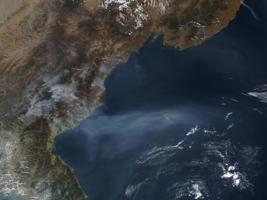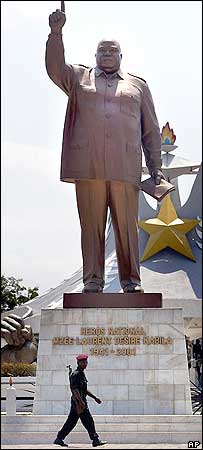UPDATE 3: According to numerous media sources, Choe Sung Chol has been shot (h/t Marmot). Read more here: Bloomberg, Reuters, Korea Times.
UPDATE 2: According to the Joong Ang Daily:
North Korea’s point man on South Korea, who was earlier said to have been sacked for misjudgment, is said to be undergoing what sources called “severe” communist training at a chicken farm, sources here said yesterday.
Choe Sung-chol, once a vice chairman of the Asia-Pacific Peace Committee, the North’s state organization handling inter-Korean affairs, was reported to have been dismissed in early 2008 for what sources called his lack of foresight on South Korea’s new conservative administration under President Lee Myung-bak.
Political dissidents in North Korea are said to often undergo training on the communist revolution. This includes hard labor in harsh environments, such as mines or in labor camps.
Choe, 52, became better known to South Korean officials and the public in 2007, when he escorted then-President Roh Moo-hyun throughout his visit to Pyongyang for a summit with North Korean leader Kim Jong-il.
He is also known to have played a key role in arranging the summit.
Officials in Seoul have acknowledged the dismissal of Choe, but could not confirm his whereabouts or why he was sacked.
“He has been undergoing training for about a year now, so it really is hard to tell whether he will be reinstated or not,” another source said, also speaking on condition of anonymity.
(UPDATE 1) Shortly after the DPRK’s ministerial and leadership changes were dscovered, the DPRK announced the Supreme People’s Assembly will be recomposed in March. According to Reuters:
The reclusive North’s official media said in a two-sentence dispatch the election for deputies to its Supreme People’s Assembly would be held on March 8, without offering details.
North Korea wants to promote economic elite to the assembly to help lay the groundwork for the next generation of its leadership, a think tank affiliated with the South’s intelligence service said in a report in December, Yonhap news agency said.
However, analysts cautioned against reading too much into the leadership changes, saying Kim Jong-il and his inner circle hold the real power while ministers and other government officials have almost no influence in forming policy.
The assembly session that typically meets in April each year is a highly choreographed affair focused on budget matters where legislation is traditionally passed with unanimous approval.
North Koreans can vote only for the candidates selected by supreme leaders who allocate assembly seats to promote rank-and-file officials and purge those no longer in favor.
“Even if we know that someone was replaced, everything related to it is pure speculation because we have no clue as to the individual inclinations of these people,” said Andrei Lankov, an expert on the North at the South’s Kookmin University. (Reuters)
The Joong Ang Ilbo provides some additional facts:
The election is also a mere formality in the North because the candidates are hand-picked by the Workers’ Party and then approved by North leader Kim Jong-il.
The five-year terms of the 687 representatives, selected in 2003, were supposed to end last September. North Korea watchers have speculated that Kim’s health was linked to the election delay. According to intelligence sources in Seoul, Kim suffered a stroke in August.
North Korea watchers said Kim’s appearance at a polling station will put an end to speculation about his health. Kim had cast ballots in the 1998 and 2003 elections, according to past North Korean media reports.
With the upcoming election, Kim’s regime will enter its third term. The newly formed legislature will, on paper, form a cabinet, devise a national budget plan and conduct foreign policy.
Following former leader Kim Il Sung’s death in 1994, the Supreme People’s Assembly did not meet for four years. At that meeting, it elected the younger Kim as the National Defense Commission chairman and officially launched his regime. At the time, the legislature also amended the Constitution and undertook a dramatic cabinet shakeup.
ORIGINAL POST
According to the Joong Ang Daily:
Yu Yong-sun, a 68-year-old Buddhist leader, has become North Korea’s senior South Korea policy maker, a top Seoul official told the JoongAng Ilbo yesterday.
Choe Sung-chol, deputy director of the United Front Department of the North Korean Workers’ Party, was in charge of Pyongyang’s South Korean affairs until early last year. After he lost the job, Yu, head of the Korean Buddhists Federation, was appointed to the post, the source said.
“Yu succeeded Choe in March last year,” the source said. “Choe was once deeply trusted by [North Korean] leader Kim Jong-il, but he stepped down because he had failed to accurately assess the outcome of the 2007 presidential election in the South, the Lee Myung-bak administration’s North Korea policy and the outlook for inter-Korean relations.”
The source also said corruption scandals involving the overseas North Korean assistance committee under the United Front Department played a role in Choe’s sacking.
Choe played a crucial role in arranging the second inter-Korean summit between the president of South Korea at the time, Roh Moo-hyun, and Kim in 2007.
Yu, the successor, is not an entirely new face in inter-Korean affairs. Since 2000, he represented the North in several rounds of inter-Korean ministerial talks. He has led the Buddhist group since May 2006.
“We’ve also obtained intelligence that Kwon Ho-ung, who used to be the chief negotiator for the inter-Korean ministerial talks, stepped down from the post and has been put under house arrest,” the source said.
The North reshuffled its cabinet recently, according to the South’s Unification Ministry. Ho Thaek, vice minister of the electric power industry, was promoted to minister. Other minister-level promotions also took place at the Ministry of Railways, Ministry of Forestry and Ministry of Foreign Trade. (Jeong Yong-soo, JoongAng Ilbo)
The Choson Ilbo reports on some more ministerial changes:
North Korea has reshuffled two cabinet ministers and appointed a new man to a key post in the Workers’ Party. North Korean state media reported that Kim Tae-bong was appointed new metal industry minister and Hur Tack new power industry minister. They replace Kim Sung-hyun and Pak Nam-chil. Kim Kyong-ok as newly-named first deputy director of the ruling party’s Organization Guidance Department that controls the party, Army and administration and is headed by leader Kim Jong-il.
It is rare for reshuffles to be announced separately. The new economic appointments may be related to the emphasis on “economic recovery” in a New Year’s statement released in the state media last week that is the closest the North has to an annual message from Kim Jong-il, a government official here speculated. The statement described the metal industry as the “pillar of the independent economy of socialism” and said the electricity, coal and railroad sectors “should take the lead in the people’s economic development through reforms.” Hence replacement of the metal and power industry ministers, according to the official. He admitted little is known about the newly appointed ministers.
The Organization and Guidance Department’s new first deputy director Kim Kyong-ok is reportedly in charge of regional party organizations.
“If the power succession is to move smoothly, the economy must be revived and control of the party organization is essential,” an intelligence officer here said. He predicted noticeable changes in the North’s power structure this year. A researcher at the Korea Institute of National Unification said North Korea “is going to take various steps in a bid to prevent Kim Jong-il’s authority from weakening due to ill health.”
And from Yonhap:
North Korea promoted industrial veterans to top posts in its latest Cabinet reshuffle, signaling Pyongyang’s stepped-up drive to rebuild the country’s frail economy, Seoul officials and analysts said Tuesday.
A reshuffle in the communist state is usually inferred when new faces appear in its media, as the country does not publicize such moves.
Five new names were mentioned as the North’s ministers of railways, forestry, electricity, agriculture and metal industry in the North’s New Year message and reports in October, Seoul’s Unification Ministry Spokesman Kim Ho-nyoun said.
“They are formerly vice ministers or those who climbed the ladder in each field. The reshuffle considered their on-spot experiences and expertise,” the spokesman said.
It was not clear when the reshuffle took place, he said.
North Korean media have been reporting a brisk campaign to rebuild the country’s ailing industrial infrastructure, following up on the New Year economic blueprint rolled out by leader Kim Jong-il. Kim called on citizens “to solve problems by our own efforts” and increase production in electricity, coal and daily equipment.
In the reshuffle, Jon Kil-su was named minister of railways; Kim Kwang-yong minister of forestry; Ho Taek minister of power industry; Kim Chang-sik minister of agriculture; Kim Tae-bong minister of metal industry.
Kim Kwang-yong and Kim Chang-sik were vice ministers and Jon held a senior post in their respective ministry. Ho was formerly a power plant chief, while little was known about Kim Tae-bong, Seoul officials said.
The shakeup was rumored to have affected more posts, but the Seoul spokesman could not officially confirm it.
Koh Yu-hwan, a North Korea studies professor at Seoul’s Dongguk University, said the reshuffle is a sign that the North is shifting its focus to the economy from the military. In its New Year message, Pyongyang pledged to build a “prosperous and powerful nation” by 2012, the 100th anniversary of North Korean founder Kim Il-sung’s birth, he noted.
“The key word this year is the economy,” Koh said. “The reshuffle seems to suggest officials with technical expertise should take the initiative to develop the economy.”
Kim Young-yoon, a researcher with the Korea Institute for National Unification, said Pyongyang is turning to its natural resources amid suspension of South Korean aid. The Seoul government halted its customary aid of rice and fertilizer this past year as Pyongyang refused offers of dialogue.
“North Korea has no other way but turn to its own natural resources as long as inter-Korean relations and the nuclear issue are in limbo,” he said.
Read the full articles here:
Buddhist leader gets North’s South policy spot
JoongAng Daily
Jeong Yong-soo
1/5/2009
N.Korea Reshuffles Economic Posts
Choson Ilbo
1/5/2009
N. Korea promotes industry veterans in Cabinet reshuffle
Yonhap
Kim Hyun
1/6/2008
North Korea says to elect MPs in government shake-up
Reuters
1/6/2009
North to hold parliamentary election
Joong Ang Ilbo
Ser Myo-ja
1/8/2009
Top North official said to be getting re-educated
Joong Ang Daily
1/12/2009


